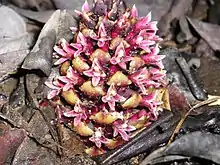| Kopsiopsis strobilacea | |
|---|---|
 | |
| Scientific classification | |
| Kingdom: | Plantae |
| Clade: | Tracheophytes |
| Clade: | Angiosperms |
| Clade: | Eudicots |
| Clade: | Asterids |
| Order: | Lamiales |
| Family: | Orobanchaceae |
| Genus: | Kopsiopsis |
| Species: | K. strobilacea |
| Binomial name | |
| Kopsiopsis strobilacea (A.Gray) Beck | |
Kopsiopsis strobilacea, the California groundcone, is a species of parasitic plant in the family Orobanchaceae.[1][2][3] It is native to California and southern Oregon, where it grows in wooded areas and chaparral. It is a parasite of manzanitas and madrones, which it parasitizes by penetrating them with haustoria to tap nutrients. The groundcone is visible aboveground as a dark purplish or reddish to brown inflorescence up to 18 cm (7.1 in) long. Pale-margined purple flowers emerge from between the overlapping bracts.[2]
Formerly considered Boschniakia strobilacea, some taxonomists now place it in the genus Kopsiopsis on the basis of phylogenetic evidence.[4]
References
- ↑ "Kopsiopsis (Beck) Beck". Plants of the World Online. Royal Botanical Gardens Kew. Retrieved 29 August 2020.
- 1 2 "Kopsiopsis strobilacea". ucjeps.berkeley.edu. Retrieved 2020-07-25.
- ↑ USDA Plants Profile for Boschniakia strobilacea
- ↑ Yu, Wen-Bin (2013-01-29). "Nomenclatural clarifications for names in Boschniakia, Kopsiopsis and Xylanche (Orobanchaceae)". Phytotaxa. 77 (3): 40–42. doi:10.11646/phytotaxa.77.3.1. ISSN 1179-3163.
This article is issued from Wikipedia. The text is licensed under Creative Commons - Attribution - Sharealike. Additional terms may apply for the media files.